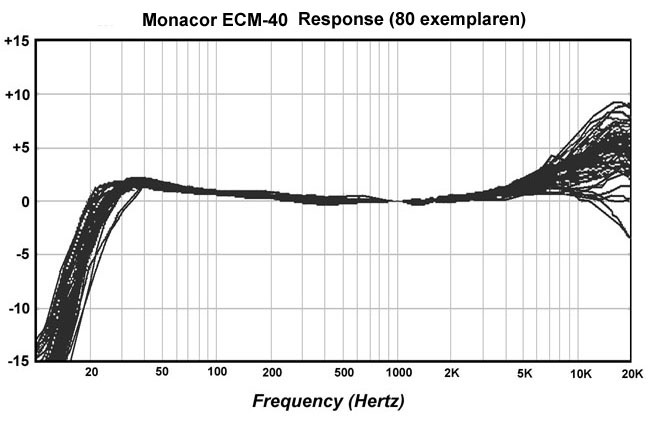Maybe, I do have a oscilloscope lying around. I guess I could measure output on my amp on one channel and the output from the laptop on the other channel and see if I can see and reduction in low frequencies. It is a NAD216 (well, actually a NAD319) amplifier.Hi barco,
At the very low end, below 20Hz it looks like your system may have a low cut filter. Do you have any way of testing for this?
Also, I dont know how good the measure equipment is on low frequencies. I borrowed it (a ECM 8000 mic and a m-audio mobilepro audiocard). I am using the calibration file for the mic, but still dont know how accurate that is on low frequencies.
Lots of unknowns
/Anders
Barco's response looks like the Hornresp sim, about a 24 dB per octave rolloff typical of tapped horns.At the very low end, below 20Hz it looks like your system may have a low cut filter. Do you have any way of testing for this?
Very deep response.
The response appears to be dropping from -36 to -60(24 dB) in just over 2/3 of an octave (10-17 Hz).Hi weltersys,
That slope below ~18Hz looks like about 44dB/octave to me, that's why I asked if there may be another filter involved.
Anyway, I like what barco was able to get out ouf the minidsp in Post #199.
Regards,
The measurement mic response (or room) could account for several dB loss down that low, my RTA-420 mic has about that much less LF response compared to my B&K 4004.
At any rate, the response is easily equalized, though if the mic is actually reading less LF response than it should (as I suspect) equalizing flat to 20 actually is a slight LF boost.
Nothing wrong with a little "loudness contour" to make up for the ear's lower sensitivity to VLF at low SPL
Art
Hi Barco,Also, I dont know how good the measure equipment is on low frequencies
Your NAD amp is about -3dB between 3Hz and 8Hz. The Behringer mics have a radical drop after their -3dB point. The -3dB can vary from 18Hz in the best case and 40Hz in the worst case, depending on the production model. At 10Hz they can vary between -6dB in the best case and -14dB in the worst case (a few measured even worse). I don't know about the missmatch in impedance because there is too much variation between the mics. Most M-Audio mic inputs should be flat till about 10Hz.
Hi Oliver,
Measurements come from well known German company, so measuring with this mic without knowing its error rate could be qualified that way.
There are a few Dutch DIY sites that provide useful info to build your own with a Sennheiser KE4-211-2i-1 capsule (89 Euro). The Behringer housing could be usefull for that
Measurements come from well known German company, so measuring with this mic without knowing its error rate could be qualified that way.
There are a few Dutch DIY sites that provide useful info to build your own with a Sennheiser KE4-211-2i-1 capsule (89 Euro). The Behringer housing could be usefull for that
Last edited:
Yes, I saw this graph when I was googling around for some info on the mic. That is why I added microphone performance as a possible (and likely) source of "unknown".
I will look into finding a better mic, but I am not really into spending a lot of money (although without good measurement, the EQ doesnt really make any sense....)
Hi Barco,
The link in my earlier post is quiet simple to build and costs about 110 Euro in parts. This Sennheiser capsule is also used in more serious measuring mics. Sennheiser does deliver a measuring chart that is pretty accurate.
The Monacor ECM-40 is a budget measuring mic (70 Euro) that seems to have better production lines and a better capsule compared to the Behringer. But its a fact that budget mics have their limits below 40Hz (for budget SPL meters its the same).

The link in my earlier post is quiet simple to build and costs about 110 Euro in parts. This Sennheiser capsule is also used in more serious measuring mics. Sennheiser does deliver a measuring chart that is pretty accurate.
The Monacor ECM-40 is a budget measuring mic (70 Euro) that seems to have better production lines and a better capsule compared to the Behringer. But its a fact that budget mics have their limits below 40Hz (for budget SPL meters its the same).

Hi Djim,
Thought you might find this interesting: ARTA Chamber for the Lower End Microphone Calibration:
http://www.fesb.hr/~mateljan/arta/AppNotes/AP5_MikroMeasChamber-Rev03Eng.pdf
Regards,
Thought you might find this interesting: ARTA Chamber for the Lower End Microphone Calibration:
http://www.fesb.hr/~mateljan/arta/AppNotes/AP5_MikroMeasChamber-Rev03Eng.pdf
Regards,
Interesting discussion!
I started looking into solutions for this "problem" with uncalibrated microphones and ran into this SOFSCI SoundSweeper Acoustic Measurement Kit | Sounds of Science
They claim:
±2dB 10Hz to 19Hz
±1dB 20Hz to 20kHz
±1.5dB 20kHz to 24kHz
Which must be considered to be very good?
I started looking into solutions for this "problem" with uncalibrated microphones and ran into this SOFSCI SoundSweeper Acoustic Measurement Kit | Sounds of Science
They claim:
±2dB 10Hz to 19Hz
±1dB 20Hz to 20kHz
±1.5dB 20kHz to 24kHz
Which must be considered to be very good?
- Status
- This old topic is closed. If you want to reopen this topic, contact a moderator using the "Report Post" button.
- Home
- Loudspeakers
- Subwoofers
- Build your own 2x12" TH (The Kraken 212 TH)


